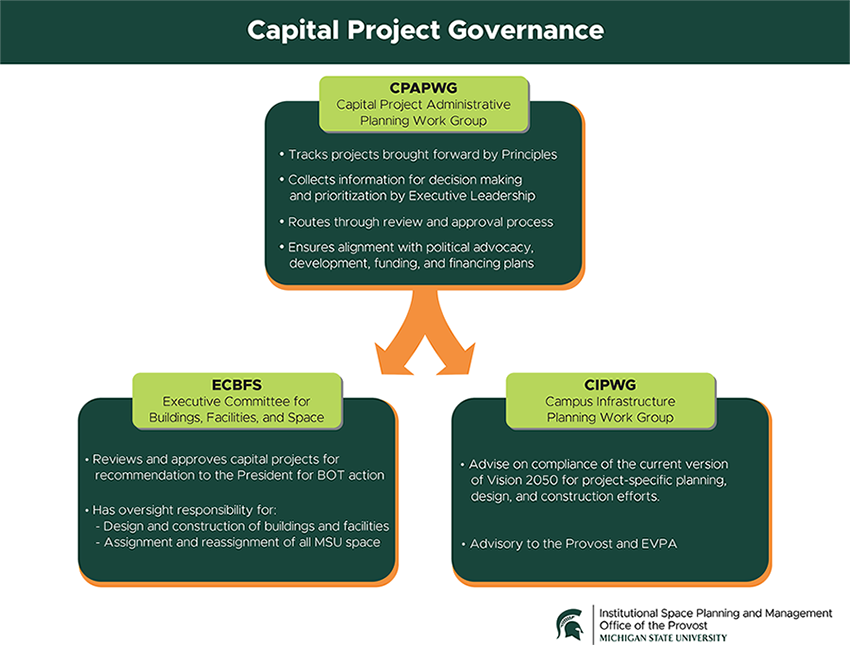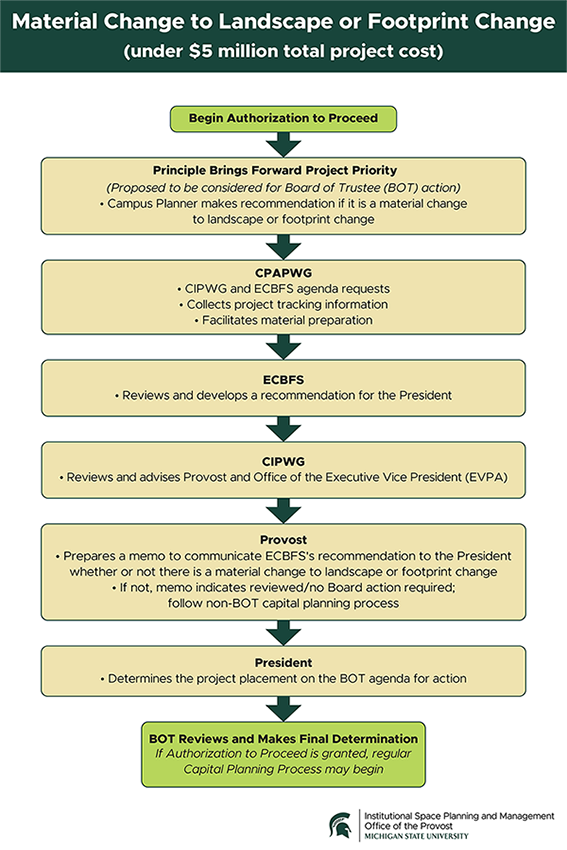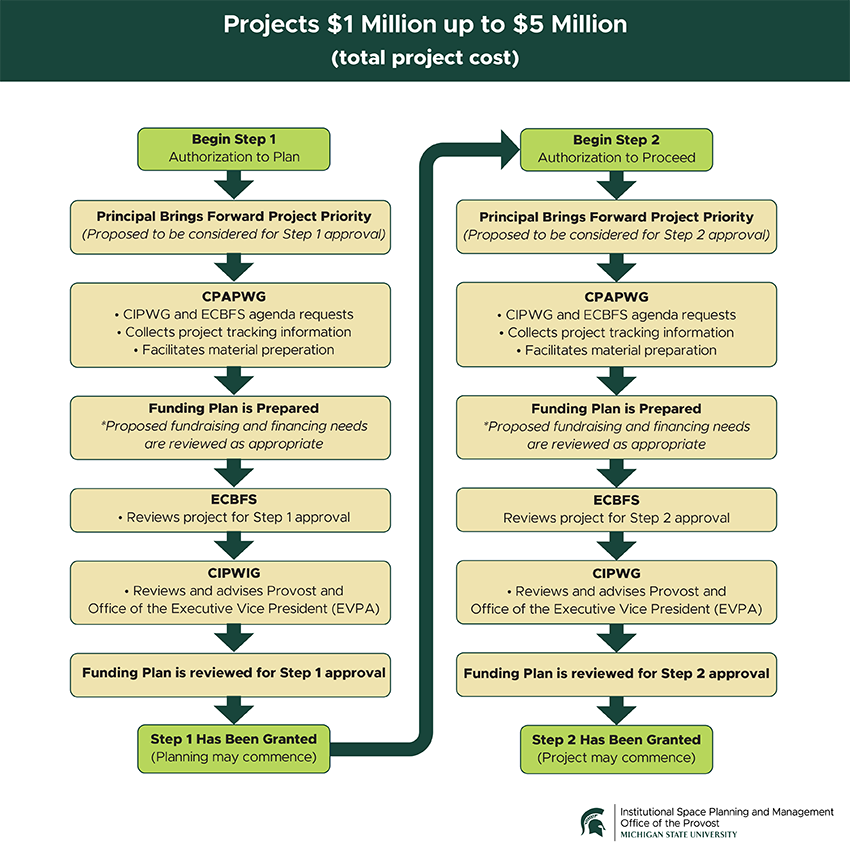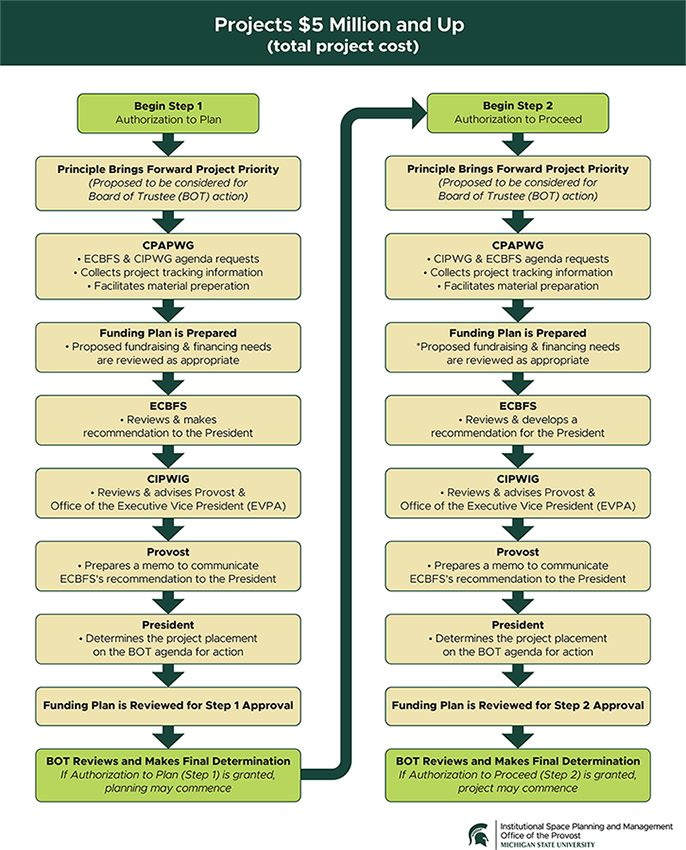- Michigan State University’s Capital Project Governance
- Capital Project Planning Process
- Governance Frameworks by Capital Project Classification
- Alterations and Improvements (A&I)
- Teaching & Learning Environment (TLE) Planning and Spending Guidelines
- About the TLE Fund and Process
- TLE Budget Request Submissions and Allocations Information
- Contact Information
Space decisions, such as reassignment, renovating, replacing, and adding buildings, are complex and on-going and involve balancing both unit and University priorities with available resources. Institutional Space Planning & Management’s (ISPM) is responsible for university-wide planning for facilities; space utilization and management; and determining the functional use of space. Units within the University can propose projects related to facilities and request space assignments through the annual Capital Project Planning Process or via special requests when necessary. Operating under the policies established by the Executive Committee for Buildings, Facilities, & Space (ECBFS), ISPM provides essential recommendations to guide the decisions of the ECBFS, Provost, and Executive Vice President for Administration (EVPA). ISPM collaborates with these units to develop proposals and implement approved decisions made by the ECBFS, Provost, and EVPA.
Michigan State University’s Capital Project Governance
The MSU Board of Trustees (BOT) regulates capital projects through specific policies:
MSU administration maintains processes to ideate capital projects in alignment with institutional strategy and needs.
- Annual Capital Project Planning Process, which is an inclusive process led by Institutional Space Planning & Management (ISPM) with broad participation from cross-campus committees and stakeholders and considers priorities from the principal University leaders: Provost, Executive Vice President for Administration (EVPA), Senior Vice President for Student Life & Engagement, and Vice President and Director of Intercollegiate Athletics, and involves key University leaders like the Provost, President, Executive Vice President for Health Sciences (EVPHS), and Executive Vice President for Administration (EVPA).
- Capital Renewal, which is managed by the Executive Vice President for Administration (EVPA).
- Opportunity-Driven Process, which are projects that arise from new funding opportunities.
- Institutional Space Planning & Management (ISPM) develops institutional space and facility strategic capital plans.
- Infrastructure Planning & Facilities (IPF) delivers approved capital projects and maintains the extant infrastructure.
The MSU President puts forth Capital Projects for consideration by the Board of Trustees (BOT) after receiving recommendations from the Executive Committee for Buildings, Facilities, & Space (ECBFS). This process includes:
- Step 1: Approval for Authorization to Plan
- Requires an approved funding plan, prior review by the Campus Infrastructure Planning Work Group (CIPWG), and the Executive Committee for Buildings, Facilities, & Space (ECBFS).
- Step 2: Approval for Authorization to Proceed
- Requires an approved funding plan, prior review by the Campus Infrastructure Planning Work Group (CIPWG), and the Executive Committee for Buildings, Facilities, & Space (ECBFS).
In the capital planning process, reviewing bodies play a crucial role in assessing and prioritizing capital project requests.
- Charge: A non-decision-making body responsible for tracking information and facilitating coordination of capital project priorities for each of the five principals (Provost, Executive Vice President for Administration, Executive Vice President for Health Sciences, Senior Vice President for Student Life & Engagement, Vice President, and Director of Intercollegiate Athletics) and ensures that priority projects are:
- Tracked for capital budget planning, reporting, and 5-year capital project planning;
- Routed through appropriate review and approval processes, including Executive Committee for Buildings, Facilities, & Space (ECBFS) and Campus Infrastructure Planning Workgroup (CIPWG); and
- Ensure that projects are aligned with political advocacy, development, and funding plans.
- Work Product: Capital budget planning support; coordination through the review and approval process by supporting coordination with committees and boards; funding plan development; and external relations communication support.
- Membership:
- Associate Director for Institutional Space Planning & Management (Co-Chair)
- Senior Budget Analyst, Office of Financial Planning & Budget (Co-Chair)
- Assistant Vice President, Real Estate & Capital Planning
- Associate Athletic Director, Facilities & Capital Projects
- Capital Renewal Planning Manager, IPF Real Estate
- Chief of Staff, Student Life & Engagement
- Senior Executive Director, University Advancement
- Space Planner/Project Manager, Office of Health Sciences
- CFO, MSU Office of Health Sciences
- Charge: An advisory body to the Executive Vice President for Administration (EVPA) and the Provost and Executive Vice President for Academic Affairs that reviews campus-wide and project-specific planning, design, and construction efforts to ensure compliance with the Facilities and Land Use Plan, including planning principles, recommendations, and the University Zoning Ordinance by:
- Reviewing and advising on major projects (projects exceeding $5 million) prior to Board of Trustee (BOT) action for Authorization to Plan (Step 1) and Authorization to Proceed (Step 2);
- Reviewing and advising for compliance of new construction and renovation projects that do not exceed $5 million that may have a footprint change, material change to landscape, or that require a zoning variance;
- Reviewing, for informational purposes only, all other projects that do not have a Facilities and Land Use Plan impact;
- Providing advice on coordination and communication guided by the expertise of its membership;
- Serving as the steering committee for future Facilities and Land Use Plan updates and the development of district-level land use plans; and
- Conducting periodic post-completion project reviews to improve committee effectiveness.
- Work Product: Project impact assessments, advisory reports, design review feedback, and coordination documents.
- Membership:
- Associate Provost for University Outreach & Engagement
- Campus Planner (Administrator)
- Campus Sustainability Director
- Environmental Health & Safety Director
- Executive Vice President for Academic Affairs
- Executive Vice President for Administration
- Executive Vice President for Health Sciences
- Facilities Planning & Space Management Director
- Director of Real Estate Operations
- MSU Police Chief
- Planning, Design & Construction Director
- Resource Center for Persons with Disabilities Director
- School of Planning, Design & Constructions Director
- Senior Vice President for Auxiliary Enterprises
- Senior Vice President for IT Services and Chief Information Officer
- University Physician
- Vice President for Intercollegiate Athletics
- Vice President for Research & Innovation
- Vice President for Strategic Infrastructure Planning & Facilities
- Vice President for Student Affairs & Services
- Vice President for University Advancement
- Water Research Institute Outreach Specialist
- Charge: An advisory committee that recommends policies for construction of new buildings and facilities and for assignment and reassignment of all University space and land, including off-campus, to the President. The Committee also has oversight responsibility for the design and construction of buildings and facilities and for assignment and reassignment of all MSU space regardless of source of funds or location. The committee is responsible for:
- Reviewing proposals related to the use of university buildings, facilities, and space for recommendation to the President or approval;
- Development of policies and guidelines for space management and utilization;
- Engaging in strategic planning to ensure efficient and effective use of campus resources;
- Coordinating with various University departments to align space management with institutional goals and priorities; and
- Receives recommendations from Campus Infrastructure Planning Work Group (CIPWG).
- Work Product: Memorandum to President (recommendation for Board of Trustee (BOT) action), Space Actions (regarding assignment or reassignment of space), review and approval of any revision to building construction standards, and space utilization reports.
- Membership:
- Provost and Executive Vice President for Academic Affairs (Chair)
- Assistant Provost, Institutional Space Planning & Management
- Assistant Vice President for Real Estate & Capital Planning
- Executive Vice President for Administration
- Senior Vice President for Health Sciences
- Office of the President, Chief of Staff
- Secretary and Chief of Staff to the Board of Trustees
- Senior Vice President and Chief Financial Officer
- Vice President for Government Relations
- Special Advisor to the Provost and Director of FRIB
- Vice President and Director of Intercollegiate Athletics
- Vice President for University Advancement
- Vice President Office of Research & Innovation
- Vice President Strategic Infrastructure Planning & Facilities
Capital Project Planning Process
The Capital Project Planning process is inclusive and collaborative, involving broad participation from various University stakeholders and integrates various planning aspects, including academic, support, human resources, fiscal, and facility infrastructure, to ensure that all relevant issues are considered and aligned with the University’s long-term direction. This comprehensive approach informs the MSU Integrated Facilities and Land Use Plan and results in an annual 5-year Capital Plan and Capital Outlay Request, which is required by the State of Michigan each October. The 5-year Capital Plan lists all potential projects, while the Capital Outlay Request focuses on one priority project for state funding. Institutional Space Planning & Management (ISPM) leads the Capital Project Planning process for primarily General Fund units and makes recommendations to the provost to ensure responsible growth that supports the University’s academic and research mission.
- November - June: Integrated and iterative planning and budget process with colleges and units.
- July/August: Update the State of Michigan 5-year Capital Plan, draft Capital Outlay Project Request, and update capital budget.
- September: Board of Trustees (BOT) reviews the draft 5-year Capital Plan, Capital Outlay Project Request, and Capital Budget.
- October: Board of Trustees (BOT) action on 5-year Capital Plan and Capital Outlay Project Request resolution.
- Board of Trustees (BOT) authorization of 5-year Capital Plan is a statutory requirement.
October 31/November 1: Board of Trustees (BOT) 5-year Capital Plan and Capital Outlay Project Request submitted to the State of Michigan following the State of Michigan’s Department of Technology, Management, & Budget (DTMB) instructions.
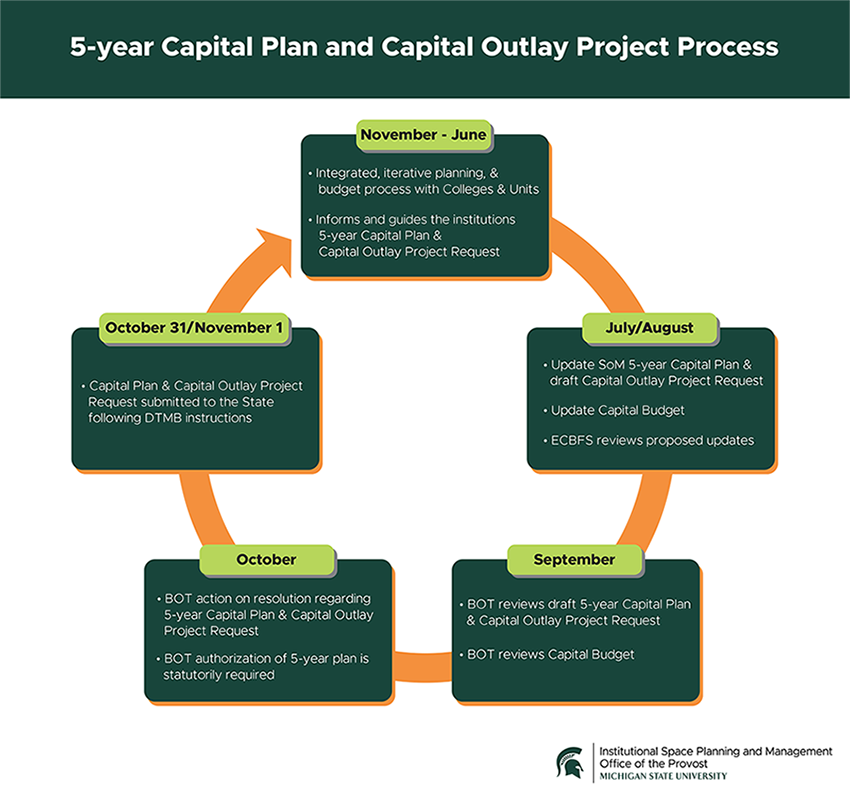
The Capital Planning Framework informs the Facilities and Land Use Plan – both are utilized in guiding capital planning at MSU.
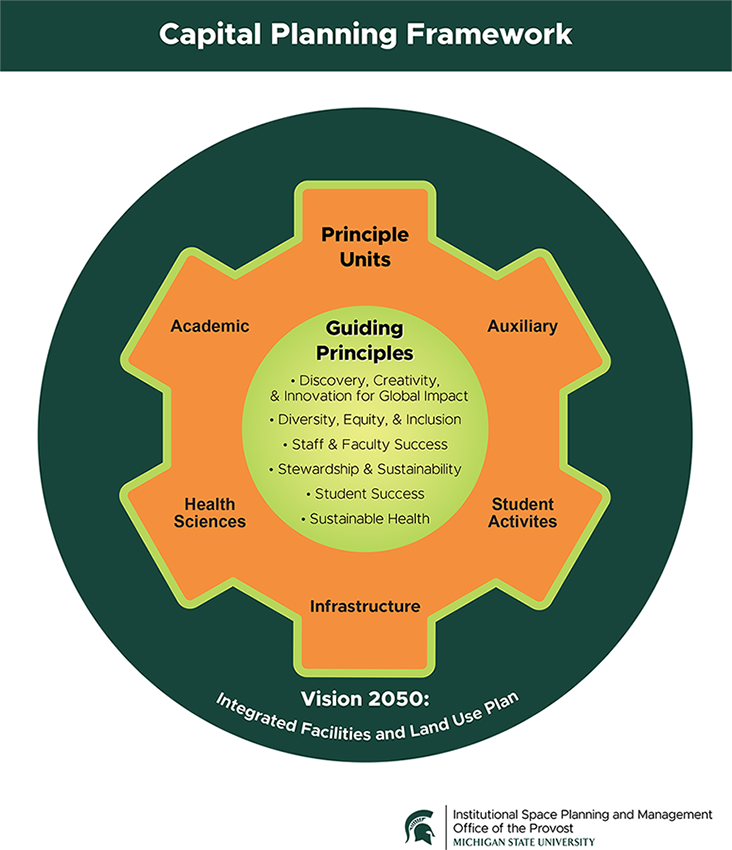
- Academic:
- Research (extramural research expenditure growth, cross-cutting themes, and areas of investment)
- Teaching and Learning (enrollment, modality, pedagogy)
- Outreach and Engagement (impact on community health and wellness, economic and social development, disparities)
- Health Education
- Auxiliary:
- Residential and Hospitality Services
- Intercollegiate Athletics
- Parking
- Health Sciences:
- Clinical Services
- Research
- Infrastructure:
- Building Systems
- Utilities
- Roads
- Bridges
- Student Activities:
- Health and Wellness
- Student Services
Capital projects require the following steps to formally submit requests for the Principal for Capital Planning Development’s consideration and prioritization via the annual Capital Project Planning Process.
Prior to the capital project process, there is a pre-planning programming work that needs to occur. ISPM should be engaged to determine the necessary pre-planning pathway. If your unit has not already engaged with ISPM on pre-planning through the annual planning process or any other means, please email ISPM@msu.edu for assistance with your capital project request.
- Idea Generated: The department/unit generates an idea for a capital project and prepares a proposal.
- Initial Discussion: The department/unit discusses the proposal and funding plan internally with the appropriate College/Major Administrative Unit (MAU).
- Programmatic Support: If the proposal has gained internal support from the appropriate College/Major Administrative Unit (MAU), then:
- Capital Project Planning Update: Proposals are provided to Institutional Space Planning & Management (ISPM) to be included in the capital project planning process via (1) the Planning and Budget meetings held annually, November through June between units and executive leadership or (2) the Capital Projects Administrative Planning Work Group (CPAPWG) annually, in June, will work with the principal units to gather priorities for consideration.
- Principals for Capital Planning Development:
- Executive Vice President for Administration
- Executive Vice President for Health Sciences
- Provost and Executive Vice President for Academic Affairs
- Vice President and Director of Intercollegiate Athletics
- Senior Vice President for Student Life & Engagement
- Broad Participation:
- Barrier-free Planning
- Capital Renewal Review Group
- Cross-college/unit space committee
- Executive Committee for Buildings, Facilities, & Space (ECBFS)
- Instructional Planning Group
- Research Space Planning
Governance Frameworks by Capital Project Classification:
Material Change to Landscape or Footprint Change (under $5 million total project cost)
A Material Change to Landscape or Footprint Change involves significant modifications to the campus environment, such as altering an existing building’s footprint or introducing new buildings and major non-building projects. Many new major construction projects will be subject to Material Change to Landscape or Footprint Change review and approval as part of the regular two-step process. However, there may be special circumstances that require a one-step process review for a Material Change to Landscape or Footprint Change only. This process specifically applies to projects under $5 million.
Initially, a Campus Planner assesses whether a proposed change qualifies as a material change. If it does, the recommendation is reviewed by the Campus Infrastructure Planning Working Group (CIPWG), followed by the Executive Committee for Buildings, Facilities, & Space (ECBFS). The ECBFS outcome is then communicated to the President by the Provost, adhering the capital planning process. Finally, the Board of Trustees (BOT) reviews and approves the changes to ensure they align with the University’s planning principles and Zoning Ordinance.
Projects $1 Million to $5 Million (total project cost)
Space projects with budgets ranging from $1 million to $5 million typically involve significant enhancements or new constructions that support the University’s strategic goals. These projects may include renovations, expansions, or the creation of new facilities to improve academic, research, and community spaces. While projects within this budget range do not require action by the Board of Trustees (BOT), each project will still undergo thorough planning and approval processes to ensure they align with MSU’s long-term vision and priorities.
Projects $5 Million and Up (total project cost)
Space projects with budgets of $5 million and up typically involve large-scale construction or significant renovations that have a substantial impact on the campus. These projects can include the construction of new buildings, major expansions, or extensive upgrades to existing facilities. They are designed to support the University’s strategic goals, enhance academic and research capabilities, and improve the overall campus environment. Projects in this budget range require thorough planning and approval processes, including review and approval by the Board of Trustees (BOT) at Step 1 and Step 2, to ensure they align with MSU’s long-term vision and priorities.
Institutional Space Planning and Management (ISPM) administers the annual budget processes for Alterations and Improvements (A&I) and Teaching and Learning Environment (TLE) on behalf of the Provost. Colleges, academic units, and academic support units may request budget allocations from these funds each year and can submit those requests through the Spartan Financial Navigator tool in EBS.
Alterations and Improvements (A&I)
Alterations and Improvement funds are designated for smaller-scale changes or enhancements supporting teaching and learning, research and outreach ranging from classroom renovations to lab and office improvements. Requests may include furnishings and equipment necessary to support the space's intended use. These alterations and improvements might be necessary due to changes in teaching methods, evolving space functions, regular wear and tear, etc.
- Programmatic Impact: Projects that enhance the ability of campus units to achieve institutional missions such as teaching, research, and service.
- Priority Designation: Endorsement as high-priority by the college or institution.
- Student Experience: Enhancements that benefit student learning and engagement.
- Research Enhancement: Initiatives that foster positive research outcomes.
- Capacity Increase: Projects that expand space utility.
- Health and Safety: Addressing safety and health concerns.
- Regulatory Compliance: Projects ensuring compliance with standards like AAALAC and accessibility requirements.
- Improving Work Environments: functionality and condition of space for faculty, staff, students, and visitors.
- Funding Opportunity: Projects with proposed matching funds from the college or department.
- Cost Details: Projects with available cost estimates.
- Coordination Opportunities: Projects that offer savings when combined with other initiatives or meet broader infrastructure needs.
- Include quotes and estimates obtained within the last year.
- Clearly define the scope of your request and provide a detailed rationale.
- Contact ISPM at ispm@msu.edu for guidance, advice on request content, or to arrange a meeting with ISPM staff to review a potential request.
- Contact ISPM following the instructions provided in your allocation letter when ready to begin your project. ISPM will disburse funding upon project readiness.
- Given that facility project timelines do not always align with fiscal year start and end dates, A&I funding allocations do not expire at the end of the fiscal year in which they are allocated.
- ISPM monitors A&I allocations and projects funded through A&I allocations for progress and reserves the right to sweep funding if the project does not progress or the need for the project is resolved through alternative means.
Teaching & Learning Environment (TLE) Planning and Spending Guidelines
(Updated July 2022)
Purpose of the TLE Fund
The Teaching and Learning Environment (TLE) fund is a strategic allocation designed to build and transform the university’s educational technology infrastructure in ways that enhance student learning and contribute to the distinction of the MSU curriculum.
Two categories of TLE funding are available:
Strategic Investment Projects
Strategic Investment Project (SIP) funding supports innovative projects and initiatives that are aligned with the long-term strategic priorities of the colleges and the university. This is the largest available pool of funding in the annual TLE budget.
Maintaining Technological Effectiveness
Another key use of TLE funds is to upgrade and refresh the existing technology environment, especially in areas that are accessible to all students. Maintaining Technological Effectiveness (MTE) funds are divided into seven sub-categories of support (in order of funding priority): classroom and laboratory upgrades, virtual learning environment, teaching and evaluation tools, graduate education, library resources, faculty computing and other infrastructure.
About the TLE Fund and Process
TLE funding is part of the annual integrated general fund planning and budget process. TLE requests are considered based on alignment with programmatic planning and facilities alterations and improvements (A&I) needs.
The TLE process begins with the announcement of the Provost’s request for proposals in early January of each year. Major Administrative Units (MAUs) are asked to complete the funding request narrative and budget template and follow the submission instructions provided to forward their prioritized request(s) to the Provost’s Office, President, or Executive Vice President.
Funding requests are reviewed for alignment with university strategic goals and priorities, readiness for implementation and appropriateness for TLE funding. Resources that faculty and students use directly in instruction and learning are most suitable for inclusion in proposals. Research or administrative resources generally are not eligible for TLE funding. Additionally, units are expected to plan for integrating maintenance and replacement of new infrastructure into their existing local operating budgets.
The Provost and Chief Information Officer collaborate to allocate TLE funds as part of the annual budget process facilitated by Institutional Space Planning and Management in coordination with MSU IT Services. Approved funding allocations are announced to MAU leadership via their budget materials and TLE communications. MAU leaders are responsible for informing departments of approved requests and communicating account information and spending guidelines.
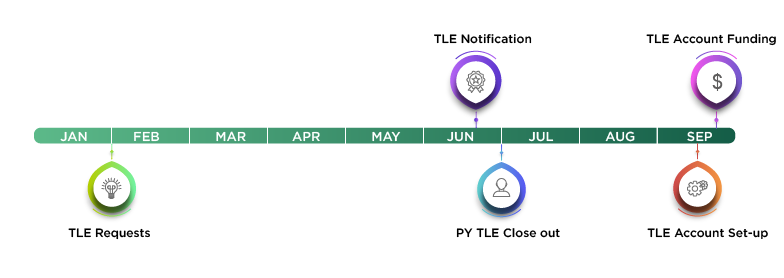
We continue to refine the TLE planning and funding process to optimize the use of available funds and expedite the modernization of campus-wide teaching and learning resources.
The greatest share of TLE funding will continue to go toward innovative projects aligned with university strategic priorities for enhancing the student experience. Units have been encouraged over the past several years to build the replacement of basic computing infrastructure, such as faculty computers, into their operating budgets versus requesting funds from TLE sources for this use. Non-faculty workstation/computer replacements and any type of payroll (e.g., students and staff) are not typically allowed expenses with TLE funds.
TLE funding is designed primarily for projects that are ready for implementation within the course of the funding year. Carrying forward unspent account balances ties up funds that could be used to mitigate the negative effects of many years of deferred maintenance of our IT infrastructure. The default action at fiscal year-end will be to sweep remaining fund balances on all accounts, including MTE accounts, and expire and close any remaining SIP accounts. Occasionally, remainders of SIP awards may be carried forward into a second fiscal year to complete a project (for example, a classroom renovation with a summer completion date). Colleges should contact Institutional Space Planning and Management (ispm@msu.edu) with a copy to IT Services (ITServices.Finance@campusad.msu.edu) to request an extension of a SIP account. Special requests to carry forward MTE funds beyond the current fiscal year should also be sent to the Institutional Space Planning and Management (ispm@msu.edu) with a copy to IT Services (ITServices.Finance@campusad.msu.edu).
IT Services partners closely with academic units, the Office of the Provost, Institutional Space Planning and Management, and Infrastructure Planning and Facilities to plan, design, coordinate and execute the IT elements of strategic projects and infrastructure maintenance.
As academic units begin to identify and prioritize technology projects that are large-scale or high impact, they should contact IT Services for technical support and guidance in adhering to university standards. In the long-term, collaboration between academic units and the technology experts in IT Services will ensure that we provide quality, effective and efficient technology across campus, achieve optimal performance of our systems and maximize utilization of scarce university resources.
Construction Projects
For projects involving construction or alteration of existing space, coordination between IT Services, Institutional Space Planning and Management (ISPM), and IPF is particularly important for timely and effective project completion. Since most TLE projects should be focused on enhancing academic spaces, TLE projects that require a construction or renovation component should be discussed with ISPM to determine the scope of the project and ultimately receive ISPM approval. Throughout the duration of the project, units are expected to continue to work with ISPM and IT Services to ensure appropriate and effective completion of projects. In the rare circumstance that a network/infrastructure project unrelated to classroom/lab space is funded with TLE resources, units are requested to route their IPF service requests through IT Services prior to submission to IPF. Once reviewed for alignment with the TLE project plan, IT Services will forward the request to IPF and continue to work with the academic unit and IPF to complete the project.
Wireless Networks & University Classrooms
Standardization of the wireless network and classroom infrastructure is critical to maintaining a stable, high-functioning technological environment that provides a contemporary, delightful customer experience to our students, faculty, staff, and visitors. With this goal in mind, all upgrades of the wireless network must be restricted to deployment of the MSUnet Wireless system and coordinated through IT Services Infrastructure.
Similarly, enhancements to TLE funded classrooms and all centrally scheduled classrooms (regardless of source of funding) must be coordinated through ISPM and IT Services Educational Technology.
Accounting Processes & Policies
A separate account is created for each new SIP project in July of each year. Spending may begin as soon as the new accounts are issued, but funding may not be available until late July or early August.
Accounts for each sub-category of MTE funding are created as needed at the beginning of each fiscal year. Once created, an MTE account may be reused in subsequent years. Sub-accounting according to college standards for each funded MTE activity is strongly encouraged on MTE accounts.
For both SIP and MTE accounts, only budgeted expenses submitted in an MAU’s TLE proposal and approved in the TLE allocation are allowable. Ancillary items that enhance the functionality of a TLE-funded resource or contribute to the project but were not included in the budget should be charged to a college or department account. If unbudgeted expenses are discovered during an IT Services account review, the fiscal officer will be required to process a distribution of expense to clear the unallowable items.
TLE accounts may not be overdrawn. Any remaining funds at the end of a project or fiscal year will be swept into a clearing account and made available for use in important technology upgrades or additional innovative projects. This practice of limiting the expense items allowed on TLE accounts simplifies account review and allows us to aggregate small remaining balances into a larger funding pool that can support worthwhile projects that would not otherwise have received funding. Additionally, to aid in tracking of expenses, the transfer of TLE funds to another account is not permitted. Rare exceptions are made for transferring TLE funds to plant accounts established for classroom renovation projects with joint funding. Permission for this is required from IT Services accounting and ISPM.
All eDocs submitted on TLE accounts must include complete documentation of the items charged and follow university guidelines as defined in the Manual of Business Procedures.
TLE Budget Request Submissions and Allocations Information
Submissions should include:
- A concise proposal for each request.
- Project description specifying how students, courses, or programs will benefit.
- Detailed budget breakdown.
- Evidence supporting your approach.
- Relevant links to planning materials, especially if related to space or renovation projects.
- Contributions from other funding sources.
- Metrics for measuring success.
Colleges interested in collaborating should clearly identify all participating colleges in the workbook. Specify which college will manage funding and how the TLE funding will be allocated among collaborating colleges.
Priority will be given to projects that:
- Programmatic impact: Enhance teaching and learning capabilities or increase course capacity.
- Funding Opportunity: Projects with proposed matching funds from the college or department.
- Coordination Opportunities: Projects that are aligned with facility renovations where cost efficiencies would be gained by improving the technology infrastructure at the same time.
- Provide specific quantities and types of equipment requested (e.g., specific number of computers, workstations).
- Provide quotes and estimates along with requests.
- Bundle similar smaller requests into one request.
This structured approach ensures that all requests are clear, aligned with university goals, and contribute effectively to our ongoing educational technology enhancements.
Follow the instructions provided in your allocation letter to access the funds. TLE funds expire at the end of the fiscal year in which they are allocated. Your unit is encouraged to proceed with project initiation and procurement of equipment approved through the TLE process as soon as funds are available.
Contact Information
TLE leaders look forward to working with you to meet the evolving technology needs of the campus community. For more information or assistance in administering and executing your TLE projects, please contact us at ISPM@msu.edu.
Barb Kranz
Provost’s Office
Assistant Provost
Administration Building
426 Auditorium Rd Rm 332
East Lansing, MI 48824
(517) 353-5062
kranzb@msu.edu
Jason Beaudin
Technology Lead
Executive Director of Educational Technology
Computer Center
450 Auditorium Rd Rm 400
East Lansing, MI 48824
517-432-5343
beaudin@msu.edu
Scott Termeer
Accounting Lead
IT Associate Director
Computer Center
450 Auditorium Rd Rm 404
East Lansing, MI 48824
517-884-6820
termeer@msu.edu
Lesley Comer
ISPM Representative
Assistant Director
Administration Building
426 Auditorium Rd Rm 340
East Lansing, MI 48824
(517) 432-9927
comerles@msu.edu
Eric Boatman
ISPM Representative
Associate Director of ISPM
Administration Building
426 Auditorium Rd Rm 334
East Lansing, MI 48824
(517) 353-5062
boatmane@msu.edu
